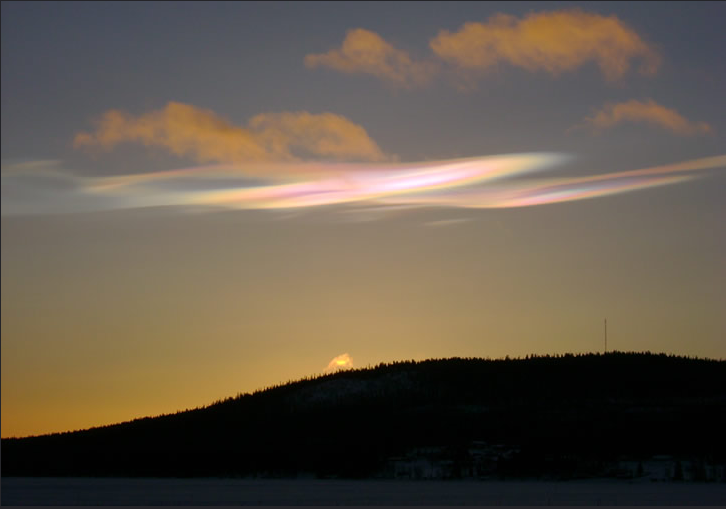Nacreous Clouds Swedish Lapland
Nacreous Clouds in Swedish Lapland: A Spectacular Atmospheric Phenomenon
Nacreous clouds, also known as polar stratospheric clouds (PSCs), are a mesmerizing and rare atmospheric phenomenon that can be observed in specific regions of the world, including Swedish Lapland. These unique cloud formations are characterized by their vibrant colors and delicate wavy sheet-like structures, creating a breathtaking spectacle in the sky.
What are Nacreous Clouds?
Nacreous clouds are formed in the stratosphere, the second layer of the Earth's atmosphere, at altitudes of around 15 to 25 kilometers (9 to 16 miles) above the Earth's surface. Unlike most clouds that form in the troposphere, nacreous clouds are composed of tiny ice crystals, which give them their distinctive appearance.
The Science Behind Nacreous Clouds
The formation of nacreous clouds is closely tied to extremely cold temperatures in the stratosphere. In Swedish Lapland, during the winter months, the polar regions experience prolonged periods of darkness, leading to a significant drop in temperatures. These frigid conditions create the ideal environment for the formation of nacreous clouds.
When temperatures plummet to around -78 degrees Celsius (-108 degrees Fahrenheit), water vapor in the stratosphere condenses onto minute particles, such as dust or meteoric debris. As the water vapor freezes, it forms ice crystals that make up the nacreous clouds. The size and shape of these ice crystals play a crucial role in the unique optical properties of these clouds.
The Spectacular Colors of Nacreous Clouds
One of the most striking features of nacreous clouds is their vibrant and iridescent colors. These colors range from vivid pinks and oranges to blues and greens, creating a stunning display in the sky. The mesmerizing hues are a result of a phenomenon called diffraction, where sunlight interacts with the tiny ice crystals in the clouds.
As sunlight passes through the ice crystals, it is diffracted or bent, causing the separation of light into its component colors. This phenomenon is similar to the way light is dispersed by a prism. The intricate structure of the ice crystals in nacreous clouds enhances this diffraction effect, resulting in the vibrant and ever-changing colors that captivate observers.
Observing Nacreous Clouds in Swedish Lapland
Swedish Lapland provides a unique vantage point for observing nacreous clouds due to its high latitude and favorable weather conditions. The region's long winter nights and cold temperatures increase the likelihood of encountering these rare cloud formations. Adventurers and photographers flock to Swedish Lapland in hopes of witnessing this awe-inspiring natural phenomenon.
To catch a glimpse of nacreous clouds, it is best to head out during the early morning or late afternoon when the sun is low on the horizon. The low angle of the sun's rays illuminates the clouds from below, intensifying their vibrant colors. It is advisable to find an open area with an unobstructed view of the sky to fully appreciate the beauty of these clouds.
The Importance of Nacreous Clouds in Atmospheric Research
Beyond their aesthetic appeal, nacreous clouds also play a crucial role in atmospheric research. These clouds provide valuable insights into the chemical composition and dynamics of the stratosphere. The presence of specific chemicals and particles within nacreous clouds can contribute to the depletion of the ozone layer, which has significant implications for global climate patterns.
Scientists study nacreous clouds to better understand the complex interactions between atmospheric components and their impact on climate change. By analyzing the composition of these clouds and monitoring their frequency and distribution, researchers can gain valuable information about the health and stability of our atmosphere.
Protecting the Fragile Ozone Layer
The formation of nacreous clouds is closely linked to the presence of certain chemicals in the stratosphere, such as chlorofluorocarbons (CFCs). These human-made compounds have been widely used in the past in various industries, including aerosol propellants and refrigerants. However, it was discovered that CFCs contribute to the depletion of the ozone layer, which protects the Earth from harmful ultraviolet radiation.
International efforts, such as the Montreal Protocol, have been instrumental in phasing out the production and use of CFCs. The reduction in CFC emissions has led to a gradual recovery of the ozone layer and a decrease in the occurrence of nacreous clouds. These captivating cloud formations serve as a reminder of the delicate balance within our atmosphere and the importance of protecting it for future generations.
Conclusion
Nacreous clouds in Swedish Lapland offer a breathtaking display of nature's artistic prowess. Their vibrant colors, delicate structures, and rarity make them a sight to behold. Beyond their aesthetic appeal, these clouds contribute to our understanding of atmospheric dynamics and the impact of human activities on the ozone layer.
As we marvel at the beauty of nacreous clouds, let us also remember the importance of environmental stewardship. By taking steps to protect our atmosphere and reduce harmful emissions, we can ensure that future generations will continue to witness the wonders of these captivating phenomena in the sky above Swedish Lapland and beyond.


Nacreous Clouds, Lapland
imaged by Phil & Jo Cooper (Discover the World) 29th January 2008 during a visit to the Icehotel at Kiruna, Swedish Lapland.
The images show well the delicate wavy sheet-like structure of stratospheric TypeII PSCs. The orange clouds are much lower tropospheric clouds caught in the last rays of the sun.
Image ©Gosia Budek, shown with permission.
Note: this article has been automatically converted from the old site and may not appear as intended. You can find the original article here.
Reference Atmospheric Optics
If you use any of the definitions, information, or data presented on Atmospheric Optics, please copy the link or reference below to properly credit us as the reference source. Thank you!
-
<a href="https://atoptics.co.uk/blog/nacreous-clouds-swedish-lapland/">Nacreous Clouds Swedish Lapland</a>
-
"Nacreous Clouds Swedish Lapland". Atmospheric Optics. Accessed on December 28, 2024. https://atoptics.co.uk/blog/nacreous-clouds-swedish-lapland/.
-
"Nacreous Clouds Swedish Lapland". Atmospheric Optics, https://atoptics.co.uk/blog/nacreous-clouds-swedish-lapland/. Accessed 28 December, 2024
-
Nacreous Clouds Swedish Lapland. Atmospheric Optics. Retrieved from https://atoptics.co.uk/blog/nacreous-clouds-swedish-lapland/.